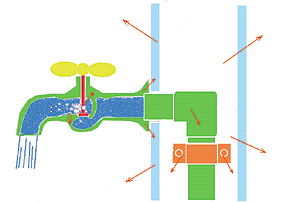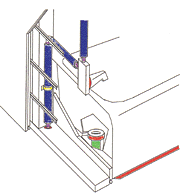

But the times are changing. The growing popularity of high-priced multi-unit housing for the aging baby boomer generation is starting to focus a great deal of consumer attention on sound isolation. Knowing how to quiet plumbing noise is a powerful tool in this market.
Sources of plumbing noise
Plumbing noise can be divided into four categories: cavitation, impact, drainage and hammer.Cavitation. As the name implies, cavitation is the production of cavities in the water. These cavities are small vacuum bubbles that quickly collapse under water pressure, producing a snapping sound. The collapse of thousands of these tiny cavities each second integrates to produce the familiar hissing of a half-opened faucet. In nature, snapping shrimp use cavitation to stun prey. When the shrimp closes its large claw, this creates a high velocity jet of water which produces several vacuum cavities. After the claw has shut, these cavities collapse in unison, producing the characteristic snap which stuns nearby prey.
In addition to high velocity, cavitation can also be produced by boiling. Put a pot of water on the stove and that first loud hissing noise you hear is cavitation. Look into the pot and you will see very small bubbles being formed at the bottom. Just as each bubble gets large enough to launch itself from the bottom, it suddenly collapses, making a small snap. Many small snaps produce the hiss of incipient boiling which also sounds exactly like that half-opened faucet.
As water flows through a valve, for example, it can travel so fast that it no longer wets the backside of the stem. A cavity is formed in the water around the stem. This cavity is basically a vacuum bubble with a little bit of water vapor and dissolved air inside it. Sections of this vacuum cavity are carried downstream by the flowing water as tiny bubbles where they suddenly collapse with a loud report. Again, many small snaps produce hissing. Cavitation can be produced in sharp bends, fittings, valves and faucets.
Currently, the only opportunity to actually prevent cavitation is in the use of continuous runs of soft copper or plastic hose that minimize the use of sharp bends and fittings. Anti-cavitation valves and faucets, though feasible, are not yet available. Until they are, the next best approach is to minimize the transfer of cavitation noise to and through the structure.
To achieve this, none of the plumbing fixtures or piping should be rigidly attached to the structure. Rubber grommets should be used where pipes penetrate walls, ceilings and floors. All supply pipe should be fully jacketed in neoprene foam. Pipe hold-down straps should be wrapped around the foam jacket, not the bare pipe. Since plastic is a lousy transmitter of sound compared to copper, plastic supply pipe is preferable. Finally, everyone involved with building a wall containing plumbing must be careful not to short circuit the efforts to isolate the plumbing from the structure.
It takes only a small piece of wood or drywall, dropped between the pipes and wallboard, to transfer and amplify all of the plumbing noise to the structure and into the next room.
Impact. Water impact noise is produced by water flowing into a tub or wash basin. The kinetic energy of the water causes the tub or basin and the water in it to vibrate. The heavier the basin and water, the lower the frequency.
Water flowing into a sink produces a high-
frequency, a shower flowing into an empty tub produces a lower frequency, a filling tub produces an even lower frequency. The method used to support the tub or basin will determine the path that impact noise will take to reach the structure. Impact noise in a claw-foot bathtub will transfer into the floor through the four cast-iron feet. Vanity basins transfer noise through the vanity cabinet. Wall- and floor-mounted fixtures transfer noise through their mountings.
Since there is no practical way to reduce the production of impact noise, the next best solution is to prevent its transfer to and through the structure. Since this noise follows definite paths to the structure, it is fairly simple to intercept. A claw-foot tub can be placed on four resilient pads. Other tubs, toilets and basins can be placed on top of rubber sheeting rather than directly on floors or subfloors. Once the structural paths have been blocked, it is also a good idea to make certain that the walls, ceiling and floor are designed for adequate sound isolation (see Walls & Ceilings July 1999 Sound Advice).
Drainage. Drainage noise is caused by the rush of water and air through traps and drainpipes. With careful design to minimize ingested air, drainage noise can be reduced. In fact, some top-of-the-line quiet-flush toilets have been computer modeled to achieve this. Bathtubs and wash basins have yet to benefit from such an approach.
Metal drainpipes work better than plastic to insulate drainage noise from the surrounding structure. As with supply pipes, drainage pipes should be insulated with neoprene foam jacketing, penetrations should use rubber grommets and pipes should not be rigidly attached to the structure.
Hammer. Water hammer is the sudden bang that shakes the entire water supply line when a solenoid valve (such as in a washing machine) shuts off. Simply put, water hammer is a momentary overpressure caused by the mass of water running into the closed valve. There are commercially available attachments to reduce water hammer. These are basically air-filled tubes that absorb the shock and reduce the banging. Since these devices don’t eliminate water hammer, it is also desirable to make sure the supply line is not rigidly attached to the studs or other structure.
Using conventional building methods, the plumbing noise transferred from a neighbors bath into the next condominium will be about 75 decibels. Follow the simple methods described above and that will fall to only 40 decibels.
With the exodus of the baby boomers into retirement condominiums, builders need all the decibel reductions they can get.


